B0041VYHGW EBOK (51 page)
Authors: David Bordwell,Kristin Thompson

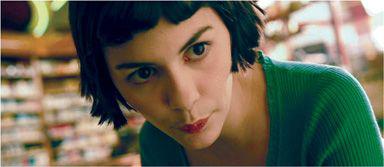
4.67 In
Amélie,
the light-hearted romantic tone is enhanced by high-key, three-point lighting.
You may have already noticed that this three-point lighting system demands that the lamps be rearranged virtually every time the camera shifts to a new framing of the scene. In spite of the great cost involved, most Hollywood films have a different lighting arrangement for each camera position. Such variations in the light sources do not conform to reality, but they do enable filmmakers to create clear compositions for each shot.
Three-point lighting was particularly well suited for the high-key lighting used in classical Hollywood cinema and other filmmaking traditions.
High-key lighting
refers to an overall lighting design that uses fill light and backlight to create low contrast between brighter and darker areas. Usually, the light quality is soft, making shadow areas fairly transparent. The frames from
Jezebel
(
4.66
) and
Amélie
(
4.67
) exemplify high-key lighting. Hollywood directors and cinematographers have relied on this for comedies, adventure films, and most dramas.
High-key lighting is not used simply to render a brightly lit situation, such as a dazzling ballroom or a sunny afternoon. High-key lighting is an overall approach to illumination that can suggest different lighting conditions or times of day. Consider, for example, two frames from
Back to the Future.
The first shot
(
4.68
)
uses high-key illumination matched to daylight and a brightly lit malt shop. The second frame
(
4.69
)
is from a scene set in a room at night, but it still uses the high-key approach, as can be seen from the lighting’s softness, its low contrast, and its detail in shadow areas.
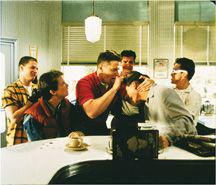
4.68
Back to the Future:
day …
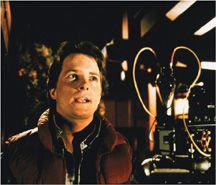
4.69 … versus night.
“When I started watching films in the 1940s and 1950s, Indian cinematography was completely under the influence of Hollywood aesthetics, which mostly insisted on the ‘ideal light’ for the face, using heavy diffusion and strong backlight. I came to resent the complete disregard of the actual source of light and the clichéd use of backlight. Using backlight all the time is like using chili powder in whatever you cook.”
— Subrata Mitra, cinematographer
Low-key illumination
creates stronger contrasts and sharper, darker shadows. Often the lighting is hard, and fill light is lessened or eliminated altogether. The effect is of
chiaroscuro,
or extremely dark and light regions within the image. An example is
4.70
, from Andrzej Wajda’s
Kanal.
Here the fill light and background light are significantly less intense than in high-key technique. As a result, shadow areas on the left third of the screen remain hard and opaque. In
4.71
, a low-key shot from Leos Carax’s
Mauvais sang,
the key light is hard and comes from the side. Carax eliminates both fill and background illumination, creating very sharp shadows and a dark void around the characters.
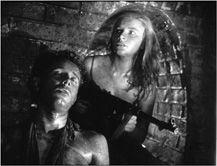
4.70 In
Kanal,
low-key lighting creates a harsh highlight on one side of the woman’s face, a deep shadow on the other.
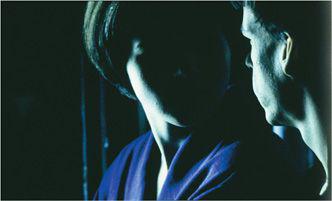
4.71 In
Mauvais sang,
a single key light without any fill on the actress’s face leaves her expression nearly invisible.
As our examples indicate, low-key lighting has usually been applied to somber or mysterious scenes. It was common in horror films of the 1930s and films noirs (dark films) of the 1940s and 1950s. The low-key approach was revived in the 1980s in such films as
Blade Runner
and
Rumble Fish
and continued in the 1990s in films noirs like
Se7en
and
The Usual Suspects.
In
El Sur
(
4.72
),
Victor Erice’s low-key lighting yields dramatic chiaroscuro effects that portray the adult world as a child imagines it.
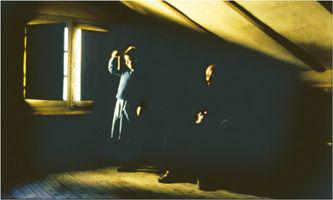
4.72 Low-key lighting in
El Sur
suggests a child’s view of the adult world as full of mystery and danger.
When the actors move, the director must decide whether to alter the lighting. By overlapping several different key lights, the filmmaker can maintain a constant intensity as actors move around the set. Although constant lighting is not particularly realistic, it has advantages, the main one being that distracting shadows and highlights do not move across actors. At the end of Fellini’s
Nights of Cabiria,
for example, the heroine moves diagonally toward us, accompanied by a band of singing young people
(
4.73
,
4.74
).
Alternatively, the filmmaker may have his or her figures move through patches of light and shadow. The sword fight in
Rashomon
is intensified by the contrast between the ferocious combat and the cheerfully dappled lighting pouring into the glade
(
4.75
).
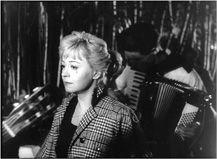
4.73 In
Nights of Cabiria,
the heroine is surounded by a band of young street musicians.
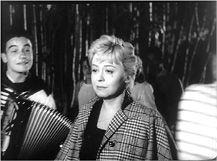
4.74 As she walks, the lighting on her face does not change, enabling us to notice slight changes in her expression.
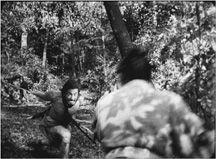
4.75 Dappled lighting in
Rashomon.
